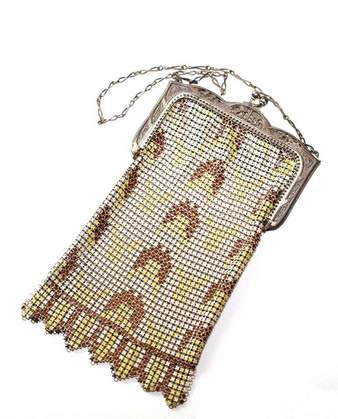Whiting & Davis Mesh Purses | Antiques & Collectibles
Whiting & Davis mesh purses are a stylish vintage accessory and a piece of New England history. I could never be a nomad. It’s not the thought of traversing distant lands that turns me off; I just seem to be incapable of packing a small bag and traveling light. Too bad, because this skill would serve […]

Coffee By Design | Portland, Maine
Photo Credit : Katherine KeenanWhiting & Davis mesh purses are a stylish vintage accessory and a piece of New England history.
I could never be a nomad. It’s not the thought of traversing distant lands that turns me off; I just seem to be incapable of packing a small bag and traveling light. Too bad, because this skill would serve me well every day; I long to be that rare woman who tosses a mere lipstick and a house key into her petite handbag before dashing out the door.

“Less is more,” I tell my inner pack rat. But with overstuffed satchel in hand, I could easily be mistaken for someone running away to join the circus (not exactly the look I’m going for). The secret that all nomads and fashionistas share is this: To get that lightweight look, you’ve got to start small. Small and smart and stylish–like the iconic mesh purses made by Whiting & Davis in the little town of Plainville, Massachusetts.
Metal mesh dates back to the Middle Ages, when chain mail was first invented. Thin strips of iron and precious metals were cut and hammered into interlocking rings, then soldered together. Mesh purses were first seen in the 1700s — but with up to 100,000 links per bag, each one made by hand, purses took weeks to produce. By the early 20th century, however, new manufacturing techniques would change all that.
In 1880, silver-jewelry manufacturer Wade & Davis hired Charles Whiting as an errand boy for 9 cents an hour. Smart and ambitious, Whiting rose to become the firm’s owner, and in 1892, the future Whiting & Davis (so rechristened in 1896) began making mesh purses. In 1912, it acquired the patent for a machine (invented by A. C. Pratt of Newark, New Jersey, in 1909) to produce mesh in a fraction of the time it took by hand.
Woven of silver, gold, gunmetal, brass, aluminum, and stainless steel, Whiting & Davis mesh moved fluidly like the finest fabric; it shimmered in the light. The mesh was attached to a hinged or accordion-fold metal frame, often embossed with a decorative pattern and suspended from a flat-link chain.
These delicate handbags were the epitome of sleek style and carefree elegance at the dawn of the modern age, and they sold for as little as $3.25.
Women were smitten. Designs became more elaborate during the Art Deco period; fringed dangles completed the flapper look, and polychrome enameling allowed for geometric patterns and pictorials. Mesh necklaces and coiled-mesh snake bracelets were also popular.
The Whiting & Davis line is still going strong (licensed to Indolink/Inge Christopher), but if you’re an aficionado of the originals, you can still find them in great condition at flea markets, auctions, consignment shops–and, don’t forget, your grammy’s closet.
Prices for vintage items range from $200 to $2,000 at auction, depending on the design and the condition of the mesh and frame. Collectors prize bags made during the late 1920s and ’30s, although you’ll find good examples into the 1950s.
Look for bags with minimal tarnish and little loss to the mesh or enamel. The hinge and clasp should work smoothly. Bags may be lined in silk, and chain lengths vary. Most are marked inside with the Whiting & Davis logo, often engraved on a cartouche secured to the mesh.
Store your bag in a cool, dry place and don’t wrap it in plastic (plastic can tarnish the metal over time).
Above all, don’t follow my example — pack your bags sparingly. The magic of mesh is in its fluid movement: Less really is more.
For more things vintage—from mesh purses to jewelry—check out these related articles: Best 5 Vintage Clothing Shops in New England Turn Vintage Doilies into Purses An Insider’s Guide to Brimfield







